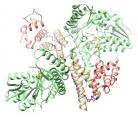CoCrMo-based metal-on-metal hip implants were introduced, particularly for younger patients, due to their superior wear resistance and theoretical mechanical advantages over other hip implant materials (especially the most commonly used metal-on-polyethylene). However, these CoCrMo-based implants suffered an unexpectedly high failure rate1 raising concerns over their safety, and leading to considerable attention in the literature on explaining the reasons behind their failure.
Approximately 1,700 scientists visit SSRL annually to conduct experiments in broad disciplines including life sciences, materials, environmental science, and accelerator physics. Science highlights featured here and in our monthly newsletter, Headlines, increase the visibility of user science as well as the important contribution of SSRL in facilitating basic and applied scientific research. Many of these scientific highlights have been included in reports to funding agencies and have been picked up by other media. Users are strongly encouraged to contact us when exciting results are about to be published. We can work with users and the SLAC Office of Communication to develop the story and to communicate user research findings to a much broader audience. Visit SSRL Publications for a list of the hundreds of SSRL-related scientific papers published annually. Contact us to add your most recent publications to this collection.
Influenza also called “Flu” is a disease of the human respiratory tract caused by influenza virus. Each year, seasonal influenza can cause severe and widespread disease in the human population and cost billions of dollars to the world economy. Such a problem occurred this year with the influenza A H3N2 virus. Currently available remedies to tackle influenza are the seasonal trivalent or tetravalent vaccines or FDA-approved antiviral drugs, such as Tamiflu and Relenza. Since influenza viruses are constantly mutating and circulating as new strains in the human population, influenza vaccines need to be updated each year. Furthermore, the efficacy of these currently available front-line drugs are declining due to the relentless evolution in the influenza virus strains (1-3).
Chromatin is the complex of DNA and proteins that comprises the physiological form of the genome. Non-covalent interactions between DNA and histone proteins are necessary to compact large eukaryotic genomes into relatively small cell nuclei. The nucleosome is the fundamental repeating unit of chromatin, and is composed of 147bp of DNA wrapped around an octamer of histone proteins: 2 copies of each H2A, H2B, H3 and H4.
Li-ion batteries (LIBs) are key components of portable electronic devices, as well as in electric vehicles, military and medical equipment, backup power supplies, and even grid storage. However, the energy storage capacity and rate capability of current LIBs is still too low to meet the increasing demand of key markets. For the latter, the properties of the electrolyte-electrode interface play a decisive role.
Since the discovery of unconventional high-temperature superconductivity (HTSC) in cuprates, one of the central questions in high Tc research is the nature of the “normal state” which develops into HTSC. As one of the pursuits of normal state properties, the recent observation of charge density wave (CDW) order is expected to shed light on the nature of the competing phases in high Tc cuprates. For this reason, CDW order in hole-doped cuprates has been actively studied by various experimental techniques such as neutron and x-ray scattering, scanning tunneling microscopy (STM), nuclear magnetic resonance (NMR), quantum oscillation, and ultrasound experiments. Among those techniques, x-ray scattering uniquely characterizes the spatial arrangement and strength of the charge density wave.
The materials and devices used in modern society are often structurally complex and chemically heterogeneous. The complexity in the material is usually caused by the desired functionality that has requirements in many different aspects of the material properties. Taking Li-ion battery as an example, the device is often evaluated by combining several different characteristics, including the energy density, capacity, cyclability, temperature stability, price etc. As a result, material scientists need to look into the realistic systems, in which both the anticipated and the unanticipated material phases/reactions occur.
The search continues for solar energy materials that are efficient and inexpensive and simple to make. Films made of metal halide perovskite crystals are good candidates because of their impressive solar cell efficiencies and their low cost to produce. An advantage of metal halide perovskite materials is the ability to tune their band gap, which determines the wavelengths of light that can be collected by the solar cell.
Cellular metabolism is essential for life. Up until recently, we knew just two methods cells use to generate and conserve the energy required for cellular metabolism: ATP hydrolysis and electrochemical ion potential across cell membranes. Recently, a paradigm-changing third mechanism was discovered, called flavin-based electron bifurcation (FBEB).
Iron-sulfur (Fe-S) clusters are cofactors that are required for the function of proteins in many critical cellular processes. All living organisms synthesize and distribute Fe-S clusters using complex biosynthetic pathways. In humans, the mitochondrial cysteine desulfurase, NFS1, is responsible for the conversion of the sulfur-containing amino acid, cysteine, to alanine and persulfide sulfur, an intermediate in Fe-S cluster synthesis. In contrast to the analogous cysteine desulfurase in prokaryotes, the eukaryotic NFS1 enzyme requires accessory proteins, ISD11 and ACP, for its function. A team of scientists investigated the structure of the NFS1-ISD11-ACP complex in order to unravel NFS1’s requirement of ISD11 and ACP for function.
Given our increasing dependence of rechargeable battery containing electronic devices, including electric cars, it is important to engineer these systems to mitigate potential for catastrophic battery failure. One possible source of lithium ion battery failure is over-discharge (over-lithiation) of the cathode, which can permanently damage the battery. Electronic battery management systems are programmed to prevent and identify such failures, but sometimes do not catch problems of over-lithiation when they occur. To better understand the characteristics of battery failure from over-discharging, a team of scientists studied the chemical and morphological changes that occur from over-lithiation of a lithium battery cathode.














